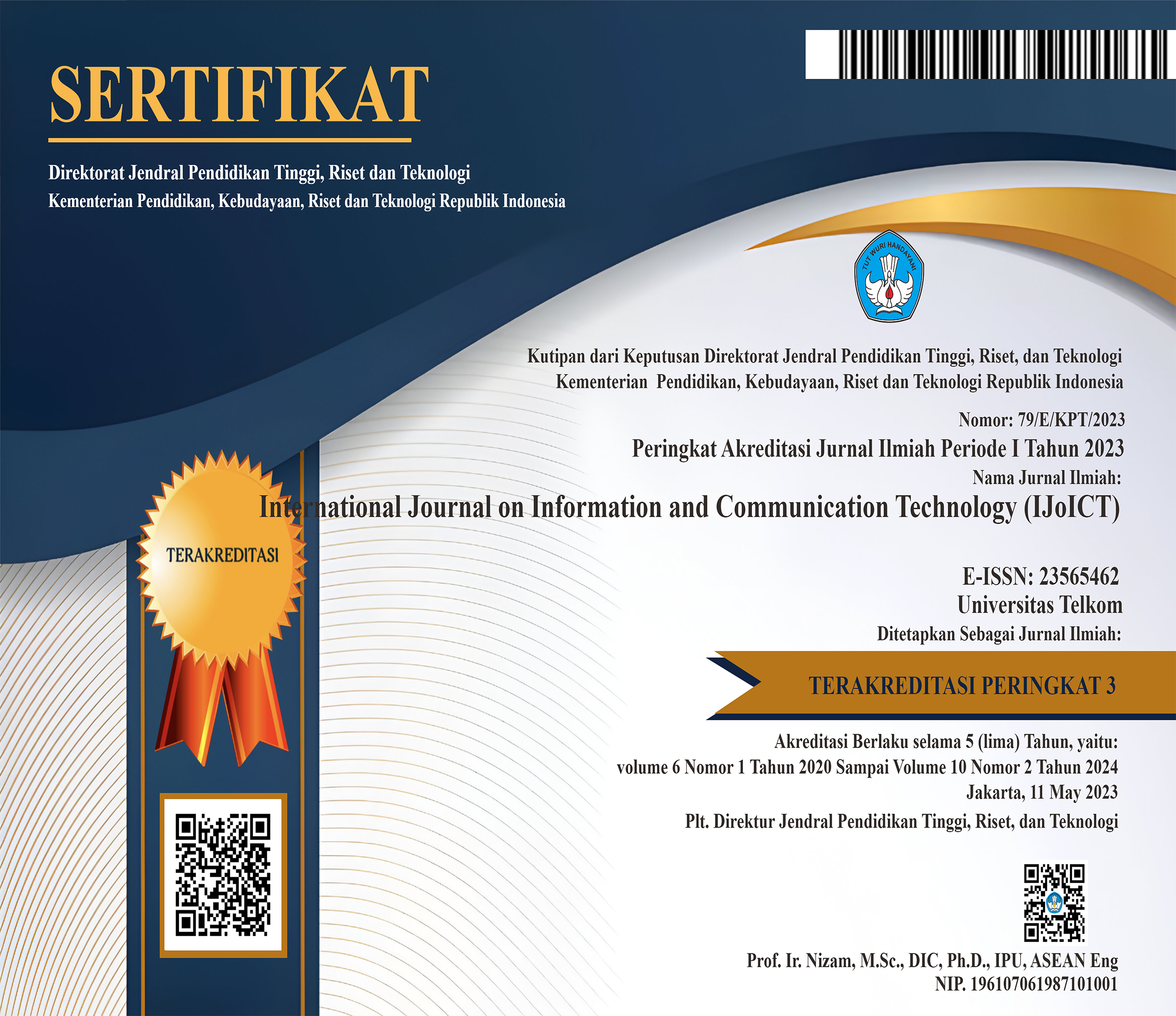Analysis of Voice Changes in Anti Forensic Activities Case Study: Voice Changer with Telephone Effect
 Abstract views: 852
,
Abstract views: 852
,
 pdf downloads: 755
pdf downloads: 755
Abstract
Voice recordings can be changed in various ways, either intentionally or unintentionally, one of which is by using a voice changer. Reference voice recordings and suspect voice recordings will be more difficult to analyze if suspect voice recordings are changed using a voice changer application under certain effects such as telephone effect. Voice Changer can be one form of activity that can be carried out by anti-forensics, making it difficult for investigators to investigate if the voice recording is changed with telephone effect. This study has two types of recordings, namely the reference voice recording (unknown sample) and suspect voice recording (known sample) that has been changed using a voice changer application with telephone effect. Investigations were carried out based on data results extraction and analysis using pitch, formant, and spectrogram using the Analysis of variance (ANOVA) method and the likelihood ratio method. The results of this study indicate that the application of voice changer can be one form of activity that can be carried out by anti-forensics so that it can be difficult for investigators to conduct investigations on sound recording evidence. This research may help forensic communities, especially investigators to conduct investigations on sound recording.
Downloads
References
K. Conlan, I. Baggili, and F. Breitinger, “Anti-forensics: Furthering digital forensic science through a new extended, granular taxonomy,†DFRWS 2016 USA - Proc. 16th Annu. USA Digit. Forensics Res. Conf., vol. 18, no. December 2015, pp. S66–S75, 2016, doi: 10.1016/j.diin.2016.04.006.
J. Sarwono, M. I. Mandasari, and Suprijanto, “Forensic Speaker Identification: An experience in Indonesians court,†20th Int. Congr. Acoust. 2010, ICA 2010 - Inc. Proc. 2010 Annu. Conf. Aust. Acoust. Soc., vol. 5, no. June 2015, pp. 3861–3863, 2010.
S. Jadhav, R. Patole, and P. Rege, “Audio Splicing Detection using Convolutional Neural Network,†2019 10th Int. Conf. Comput. Commun. Netw. Technol. ICCCNT 2019, pp. 1–5, 2019, doi: 10.1109/ICCCNT45670.2019.8944345.
H. Zhao, Y. Chen, R. Wang, and H. Malik, “Anti-Forensics of Environmental-Signature-Based Audio Splicing Detection and Its Countermeasure via Rich-Features Classification,†IEEE Trans. Inf. Forensics Secur., vol. 11, no. 7, pp. 1603–1617, 2016, doi: 10.1109/TIFS.2016.2543205.
R. K. Chan, “Speaker discrimination: Citation tones vs. coarticulated tones,†Speech Commun., vol. 117, no. June 2019, pp. 38–50, 2020, doi: 10.1016/j.specom.2019.06.006.
P. R. Bevinamarad and M. S. Shirldonkar, “Audio Forgery Detection Techniques: Present and Past Review,†no. Icoei, pp. 613–618, 2020, doi: 10.1109/icoei48184.2020.9143014.
A. Subki, B. Sugiantoro, and Y. Prayudi, “Analisis Rekaman Suara Voice Changer dan Rekaman Suara Asli Menggunakan Metode Audio Forensik,†Indones. J. Netw. Secur., vol. 7, no. 1, 2018.
W. Zhenhua, W. Yingli, and D. S. Nanda, “Forensic Linguistic Inquiry into the Validity of F0 as Discriminatory Potential in the System of Forensic Speaker Verification,†J. Forensic Sci. Crim. Investig., vol. 5, no. 3, pp. 1–8, 2017, doi: 10.19080/jfsci.2017.05.555664.
M. A. Wani, A. AlZahrani, and W. A. Bhat, “File system anti-forensics – types, techniques and tools,†Comput. Fraud Secur., vol. 2020, no. 3, pp. 14–19, 2020, doi: 10.1016/S1361-3723(20)30030-0.
F. Sulianta, Komputer Forensik. Indonesia: Elex media Komputindo, 2013.
M. A. Qureshi and E. S. M. El-Alfy, “Bibliography of digital image anti-forensics and anti-anti-forensics techniques,†IET Image Process., vol. 13, no. 11, pp. 1811–1823, 2019, doi: 10.1049/iet-ipr.2018.6587.
P.-J. Moon, “On the Availability of Anti-Forensic Tools for Android Smartphones,†J. Korea Inst. Electron. Commun. Sci., vol. 8, no. 6, pp. 855–861, 2013, doi: 10.13067/jkiecs.2013.8.6.855.
Q. Yan, R. Yang, and J. Huang, “Robust copy-move detection of speech recording using similarities of pitch and formant,†IEEE Trans. Inf. Forensics Secur., vol. 14, no. 9, pp. 2331–2341, 2019, doi: 10.1109/TIFS.2019.2895965.
A. Subki, B. Sugiantoro, and Y. Prayudi, “Membandingkan Tingkat Kemiripan Rekaman Voice Changer Menggunakan Analisis Pitch, Formant dan Spectogram,†J. Teknol. Inf. dan Ilmu Komput., vol. 5, no. 1, p. 17, 2018, doi: 10.25126/jtiik.201851500.
V. R. . Putri, “Analisis Rekaman Suara Menggunakan Teknik Audio Forensik Untuk Keperluan Barang Bukti Digital,†Unnes Phys. J., vol. 3, no. 1, 2014.
H. Cao, “the Role of the First Five Formants in Three Vowels of,†no. August, pp. 617–621, 2019.
M. N. Al-Azhar, Digital Forensic Practical Guidelines For Computer Investigation. Jakarta, 2010.
Y. Ren, D. Liu, Q. Xiong, J. Fu, and L. Wang, “Spec-ResNet: A General Audio Steganalysis scheme based on Deep Residual Network of Spectrogram,†pp. 1–12, 2019.
R. C. Maher, “Audio Forensic Examination: Authenticity, enhancement, and interpretation,†Ieee Signal Process. Mag. [84], no. March, pp. 84–94, 2009.
R. R. Huizen, N. K. D. A. Jayanti, and D. P. Hostiadi, “Analisis Pengaruh Sampling Rate Dalam Melakukan Identifikasi Pembicara Pada Rekaman Audio,†Konf. Nas. Sist. Inform., 2015.
V. Hughes, P. Harrison, P. Foulkes, P. French, C. Kavanagh, and E. S. Segundo, “The individual and the system: Assessing the stability of the output of a semiautomatic forensic voice comparison system,†2018, doi: 10.21437/Interspeech.2018-1649.

This work is licensed under a Creative Commons Attribution 4.0 International License.
Manuscript submitted to IJoICT has to be an original work of the author(s), contains no element of plagiarism, and has never been published or is not being considered for publication in other journals. Author(s) shall agree to assign all copyright of published article to IJoICT. Requests related to future re-use and re-publication of major or substantial parts of the article must be consulted with the editors of IJoICT.









.png)

.jpg)




